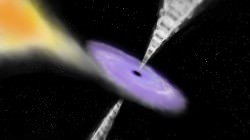This image, right here, shows us the value of long-term observations. It’s a composite of pictures taken between 1999 and 2012 from NASA’s Chandra X-ray Telescope. Put 9.5 days’ worth of observations together, and you can see a lot of action in Centaurus A — namely, a huge jet emanating from a ginormous black hole embedded in the galaxy.
“As in all of Chandra’s images of Cen A, this one shows the spectacular jet of outflowing material – seen pointing from the middle to the upper left – that is generated by the giant black hole at the galaxy’s center. This new high-energy snapshot of Cen A also highlights a dust lane that wraps around the waist of the galaxy. Astronomers think this feature is a remnant of a collision that Cen A experienced with a smaller galaxy millions of years ago,” NASA stated.

A past survey of X-ray sources in Cen A revealed that most of them are black holes or neutron stars (the latter created from the wake of a huge star’s collapse). It seems that most of these sources are either less than twice the mass of the sun, or more than five times as massive. Here’s the more interesting bit: the smaller ones appear to be neutron stars, and the bigger ones black holes.
“This mass gap may tell us about the way massive stars explode. Scientists expect an upper limit on the most massive neutron stars, up to twice the mass of the Sun,” NASA added.
“What is puzzling is that the smallest black holes appear to weigh in at about five times the mass of the Sun. Stars are observed to have a continual range of masses, and so in terms of their progeny’s weight we would expect black holes to carry on where neutron stars left off.”
The 2013 paper is available both in The Astrophysical Journal and in preprint version on Arxiv.


Ginormous? Is that a technical term I am not familiar with?
I can’t make any sense of what I’m reading here. Is the study about the ‘ginormous’ SMBH, the jets, the dust lane, or stellar X-ray sources in Cen A?
Thankfully the arXiv summary explains it: it’s about the mass distribution of ‘low mass X-ray binaries’ in Cen A, both black holes and neutron stars, which may or may not reside in the dust lane.
And no, the jet doesn’t ‘highlight the dust lane’.
Agree. Really interesting image. Would like to know what the big bubble is bottom right.
The bubble at bottom right is a thin x-ray emitting shell of gas that surrounds the southwest radio lobe of Centaurus A and was created by the supersonic inflation of the lobe. Details of observations and models of this x-ray bubble can be found here:
http://arxiv.org/abs/astro-ph/0304363
http://arxiv.org/abs/astro-ph/0410299
The bubble at bottom right is a thin x-ray emitting shell of gas that surrounds the southwest radio lobe of Centaurus A. The supersonic inflation of the radio lobe compressed and heated the surrounding interstellar medium, causing it to glow in x-rays.
(my earlier comment with links is still in moderation)
I too had difficulty understanding sections of text. And though aspects of image are unclear ( as noted ), dramatic nature is evident in those colossal particle-beam(?) jets.
In Grand Pavilion of immense Creation, woven with energy lines through dimensions of space, in frames of darkness and light, one narrow-band view into the breathtaking glory and power, wonder and mystery of the material Universe! What measures of depth remain unfathomable, in prism-light unseen ( unrealized in time ), hidden in magnificent astronomical images such those of mighty Centaurus A?